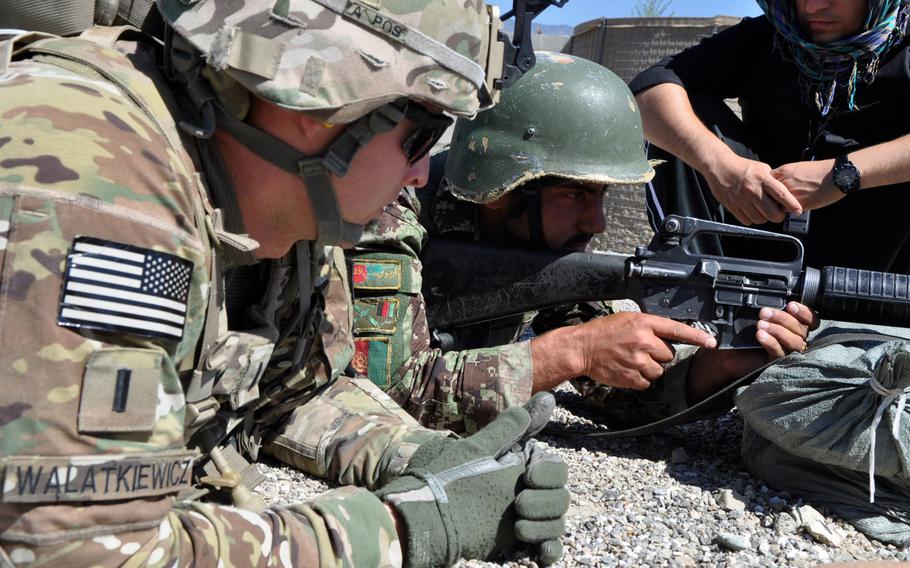
First Lt. Jon Walatkiewicz, an adviser with a 1st Brigade Combat Team, 101st Airborne Division Security Force Assistance Team, helps Afghan National Army soldier Hayakhan adjust and fire his M-16 rifle during training at Forward Operating Base Joyce in eastern Afghanistan on June 8, 2013. (Josh Smith/Stars and Stripes)
KABUL, Afghanistan — President Barack Obama declared this week that the U.S. military has reached a “turning point,” but when NATO’s military coalition begins a new mission in Afghanistan at the end of the month, little is likely to change for the thousands of troops whose deployment extends into next year.
NATO’s International Security Assistance Force — and the U.S. government — have emphasized that the transition from ISAF to Operation Resolute Support marks the end of international troops’ combat mission in Afghanistan, as the new mission is focused primarily on training and advising. But defining the difference between the two missions may be largely semantics.
For more than a year now, coalition forces have already been transitioning to a more training-centered mission, with progressively fewer and fewer units dedicated to offensive operations. That, combined with Obama’s decision to allow American troops deployed as part of the new Resolute Support mission to engage in combat operations in certain circumstances, means foreign forces here now will see few major changes when the long-awaited transition occurs.
That decision appears to have been motivated in part by the worrying parallels to Iraq, where the U.S.-trained army was left without outside support after the withdrawal of American forces at the end of 2011. The army promptly collapsed last summer in the face of a surprise offensive by a small force of well-armed and well-financed Islamic militants who quickly occupied Mosul, Iraq’s second-largest city, along with wide swathes of territory in the north and west.
“The time of deploying large ground forces with big military footprints to engage in nation building overseas, that’s coming to an end,” Obama told 3,000 troops Monday at New Jersey’s Joint Base McGuire-Dix-Lakehurst, a launching point for deployments to Afghanistan.
Resolute Support, which will have about 12,000 troops, about 10,000 of them American, is aimed at “training, advising, and assisting” Afghan forces.
What exactly “assisting” will look like, however, is not entirely clear. Obama recently signed an order opening the door to continued American combat operations in coming years, such as when troops are threatened. Also, the coalition told Stars and Stripes recently it intends to provide air support to Afghan units if requested. A certain number of special operations units will also be tasked with combating any al-Qaida elements.
U.S. Air Force Capt. Frank Hartnett, an ISAF spokesman, insisted the coalition still intends to “cease combat operations” while focusing on the challenge of advising Afghans in high positions such as in the various ministries.
“Soon, we will case the ISAF colors and remove our ISAF patches and we’ll unfurl the RS banner and replace the patches on our uniforms,” he told Stars and Stripes in an email statement. “Thanks to proper planning and consistent effort, many units are already well on their way to the RSM transition. Due to the size and scope of ISAF’s responsibilities a carefully planned drawdown was needed to ensure a smooth transfer to our next mission.”
Coalition casualties have dropped drastically as offensive combat operations have been curtailed over the past year. But combat, while less of a focus, has remained a constant possibility for the heavily armed NATO servicemembers in Afghanistan. Now, the continuing — and in some areas increasing — violence in Afghanistan, aimed both at Afghan forces and at foreigners, means foreign troops will still face daily risks.
On Sunday, the Department of Defense identified two American soldiers who died Friday in an attack near Bagram Air Field north of Kabul. U.S. Army Spc. Wyatt J. Martin of Mesa, Ariz., and Sgt. 1st Class Ramon S. Morris of New York, N.Y. were killed when a roadside bomb hit their vehicle. At least 2,212 American servicemembers have died in Afghanistan since the U.S.-led invasion in 2001, according to a tally by The Associated Press.
Such incidents, as well as so-called insider attacks by Afghan forces, are likely to remain a daily concern for troops, even if they aren’t engaged in offensive combat operations.
The international military effort will be different than it was during the high points of “the surge” beginning in 2010 when tens of thousands of American and allied troops fought hard battles against entrenched insurgents. Years later, however, that insurgency is still a threat and the roughly 350,000 Afghan forces NATO will be advising are taking fearful casualties.
Standing back and advising as the conflict continues unabated may be a difficult personal transition for some troops who experienced the heated fighting of past years, Army Maj. Gen. John Murray, deputy commander for support at U.S. Forces Afghanistan, said in a statement last week.
“We’ve been in and out of this country for 13 years, and now the biggest change is the mindset,” Murray said. “Soldiers are coming back for their third or fourth rotation, but this is going to be fundamentally different. Those coming to the command need to approach it with a fresh perspective and an open mind.”
smith.josh@stripes.com Twitter: @joshjonsmith